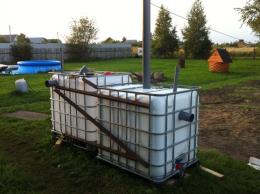Search
Login
Do-it-yourself septic tank from eurocubes on a personal plot
Since the main criterion for both comfort and home improvement on a personal plot was the presence of all the benefits of civilization, the owners of suburban territories are increasingly striving to equip their possessions according to all the canons of Eurostyle and urban housing. Due to the fact that the main element and sign of improvement, ensuring a high standard of living, is an autonomous sewer system, a rare owner of a suburban area refuses to equip it. Having decided to organize a sewage system, some prefer the most low-cost version of the drainage pit, but the development of innovative technologies allows you to choose a more modern and practical and most simplified way to equip the engineering system in a private house with a septic tank made of European cubes.
Content
- Septic tank from Eurocubes. Main advantages
- The principle of operation of a septic tank from Eurocubes video
- How to make a septic tank from eurocubes? Preparatory Activities
- The choice of territory and the calculation of the volume of containers: what should be taken into account?
- Arrangement of a septic tank: sequence of work video
Septic tank from Eurocubes. Main advantages
In the process of arranging a septic tank from European cubes with their own hands, it is supposed to use specialized cubic containers called Eurocubes as a collection tank for accumulating liquid waste.


They are plastic drives that are placed in a metal frame made of steel profiles. The direct manufacture of containers involves the processing of polyethylene, characterized by resistance to aggressive reagents, which guarantees additional wear resistance. The strength of the containers gives the presence of internal corner guards. The volume of containers is excessively diverse, the minimum is in the range of 640 liters, the maximum can reach 1250.

In addition to the above characteristics, Eurocubes are characterized by:
1. Absolute tightness of a design;
2. High stability achieved due to the steel frame;
3. Increased stability due to the ergonomic shape of the cube and the presence of a steel frame.
It is important to note that the original purpose of the Eurocubes is to transport chemically aggressive media, as a result of which the Eurocubes can be considered the ideal material for creating a septic tank in a personal territory.

The principle of operation of a septic tank from Eurocubes
The functional purpose of a home-made septic tank from eurocubes is implemented according to the following principle:
1.From the equipment installed in the living room, the sewage flows through the pipes into the first septic tank, designed to settle the heaviest and largest particles.

2.After this, through the connecting pipe, due to the assumed height difference between adjacent containers, they enter the next container, from where they enter the soil through a drainage pipe localized 20 cm below the previous container.

Thus, the basis of the operation of the structure, constructed from Eurocubes, is a structure consisting of two levels, due to which coarse-grained and liquid wastes are separated. Liquid waste, purified from coarse impurities, is then biodegradable under the influence of anaerobic flora, which is created by adding specialized bioactive substances to the septic tank.
How to make a septic tank from eurocubes? Preparatory Activities
Before we answer the fundamental question: How to make a septic tank from Eurocubes ?, we will clarify that before buying containers for its arrangement, a number of preparatory measures are carried out, the most important of which is the choice of a favorable location and the calculation of the proper volume of the building necessary for the proper disposal of waste.

When planning the location of the sewage system, the following points should be carefully considered:
1. Residential buildings should be located no closer than 5 meters from the treatment plant;
2. When planning the installation of a septic tank from European cubes, you must develop a pipeline project so that it provides for a slope of at least 2 cm per meter of its length;

3. When organizing a septic tank, it is advisable to avoid bends in the sewer pipe, but if this is not possible, it is necessary to provide for the installation of an additional well.

The choice of territory and the calculation of the volume of containers: what should be taken into account?
When choosing the location of a septic tank, it is important to avoid various extremes. So, for example, an excessively long distance from residential buildings to a septic tank contributes to difficulties in designing external sewers, due to the mandatory slope of the pipes. In addition, the length of the pipeline determines the depth of the pit, and the larger it is, the deeper the pit must be prepared for the installation of tanks. Excessive piping lengths increase blockages.

As for calculating the volume of the tank for autonomous sewage, it depends on the amount of incoming liquid waste, which is calculated according to the same scheme as for a traditional drain pit. If the calculation is made according to normative indicators, according to which one person consumes an average of up to 200 liters of water per day, then for a family of four people, the optimal depth of the septic tank (according to the norms equal to three times daily consumption) will be 1500-1800 liters.

Having prepared two Eurocubes for a septic tank and tuned in for the installation of a septic tank, it is important to follow a certain sequence of work.
The construction of the septic tank begins with the preparation of a trench for the pipeline and the pit for the installation of tanks, the volume of which corresponds to the volume of the containers plus 10-15 cm. The depth of the pit depends on the height of the containers and the expected slope. At the bottom of the pit, a gravel layer is arranged and poured with cement mortar, remembering the installation of loops to fix the containers.


Arrangement of a septic tank: sequence of work
For the device of the septic tank, two cubes will be required, which need advance preparation. It is necessary to mount tees in the neck of the drives, and in the lateral parts of the tanks - make the holes necessary for the installation of the outlet pipeline.

In the first cube, a hole is made that is necessary to bring the pipe and the subsequent connection of the septic tank and the internal system. It is important to remember that when connecting the sewerage elements, you can not neglect the high-quality sealing of the joints.
Equipping ventilation, a hole is made in the container directly above the tee, designed to install the pipe.

At the same time, on the opposite side of the tank, make an outlet of the same diameter, located at a lower level. Given the lower localization of the second container (approximately 25 cm lower), a similar hole is made in it.

The tees are mounted to the connecting pipe, and ventilation ducts are installed at the top. Do not forget to handle joints with sealant. If a technological section was made to install the tees, it is fastened and sealed with a sealant, and subsequently the waterproofing material is deposited. Next, the containers are connected by welding, preventing their displacement.

The scheme of a septic tank from eurocubes is presented below:

After the concrete bottom of the pit has completely dried, the connected containers are installed in it and fixed to the previously installed loops by means of a cable.
To prevent displacement of the structure in the pit, the gaps between the accumulators and the soil are concreted by pre-filling them with water.

To ensure the normal functioning of the flora, it is recommended to maintain the temperature at the proper level. For these purposes, experts suggest resorting to thermal insulation, which consists in covering the septic tank with a sheet of polystyrene foam. This is done after installing the containers in the pit, after which they are covered with a layer of soil so that only ventilation holes and treatment pipes remain on the surface.

At the final stage, drainage pipes are installed, for which pipes equipped with perforations and characterized by a diameter not exceeding 50 mm are used. Wiring of drainage pipes begins to be mounted, starting from the outlet of the second container, which is recommended to be covered with a layer of gravel that improves drainage of wastewater.






